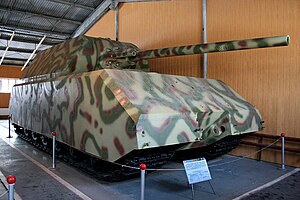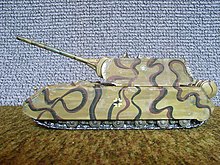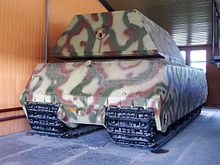Panzerkampfwagen VIII Maus
| Panzerkampfwagen VIII Maus | |
|---|---|

Panzerkampfwagen VIII Maus in the Kubinka Tank Museum |
|
| General properties | |
| crew | 6 (commander, driver, radio operator, gunner, two loaders) |
| length | 10.09 m |
| width | 3.67 m |
| height | 3.80 m |
| Dimensions | 188 t |
| Armor and armament | |
| Armor | 50-220 mm |
| Main armament | 12.8 cm KwK44 L / 55 |
| Secondary armament |
7.5 cm KwK 44 L / 36.5 7.92 mm MG 42 |
| agility | |
| drive |
Twelve-cylinder - V engine Daimler-Benz MB 509 794 kW (1,080 hp) |
| Top speed | 20 km / h |
| Power / weight | 5.74 hp / t |
| Range | 186 km |
The Panzerkampfwagen VIII "Maus" was a super-heavy tank of the Wehrmacht produced by the company Porsche , of which two prototypes had been completed by the end of 1944 , but which were never used in combat. It was only surpassed in size by the designs for the P-1000 and P-1500 . The internal Porsche project number for the mouse was 205, with the first mouse completed being number 205/1 and the second number 205/2.
Development history
As early as 1941, the Krupp company received the development contract to build a 100-ton tank. The studies that followed on 110, 130, 150 and 170 ton tanks never got beyond the drawing board stage . The alias "Mammut" intended for this project was discarded for camouflage reasons and changed to "Mouse".
On March 21, 1942, Hitler instructed the Porsche company to also design a 100-ton vehicle. After comparing the two competing designs by Krupp and Porsche in January 1943, Hitler preferred the Porsche version. On May 1, 1943, Hitler was shown a wooden model of the mouse. The projected weight of the mouse of around 150 tonnes increased to 188 tonnes V1 and 187 tonnes V2 due to the repeatedly reinforced armor (up to 220 mm) (weight savings thanks to drilled rollers) and presented the Porsche design group with difficult problems with the engine. The drive was petrol-electric, with an internal combustion engine driving an electric generator via an intermediate gear, which was used to supply power to two electric motors (similar to the diesel-electric drive ). These set the vehicle in motion via planetary gears . In the mouse 205/1 of the generator came one of the drive Daimler-Benz developed modified DB-603 - aircraft engine used, the MB 509 with an output of 1,080 hp. Due to its enormous gasoline consumption of 3800 liters per 100 kilometers off-road, the second prototype 205/2 was equipped with a similarly powerful V12 diesel engine (MB 517). The main armament consisted of the 12.8 cm chariot gun (KwK), which was also used in the Jagdtiger , and a 7.5 cm KwK44 / L36.5 parallel to the axis . An MG42 was installed parallel to the axis in the turret for close defense .

Completion and testing
On December 24, 1943, the first mouse was assembled at the Alkett company in Berlin . After a first successful driving test at Alkett, the mouse was subjected to the first tests in the Army Research Institute in Kummersdorf near Berlin. Due to the heavy bombing and difficult procurement of spare parts, further tests were carried out from January to the beginning of October 1944 near the Porsche works on the grounds of the armored barracks in Böblingen . However, the test drives had to be carried out with a dummy corresponding to the tower weight of 55 t , as the Krupp company commissioned with the tower production was behind with the delivery due to the Allied air raids on Essen. On April 9, 1944, Krupp delivered the tower, which was installed immediately. After assembly, the mouse 205/2 arrived at Alkett on March 1, 1944 in Böblingen to install the drive and was tested in Böblingen. There are many pictures of this. At the end of 1944 both tanks were sent to the “ VersKraft neu ” in Kummersdorf. 150 pieces of the mouse were to be built; however, all work on super-heavy tanks was stopped in 1944 and the planned series production of the Maus was therefore canceled. Only two copies were completed, five more were under construction.
Remaining after the end of the war
At the end of April 1945, both prototypes were on the army test site in Kummersdorf, where the Maus 205/2 was blown up by the Wehrmacht on Hindenburgplatz in Wünsdorf when the Soviet troops approached . Mouse 205/1, left behind on the firing range, was captured by the Red Army in a slightly damaged condition . They built the tower of Maus 205/2 on the hull of 205/1 and sent the vehicle to Kubinka for test purposes in 1945/46 . After the end of the test in 1951, all units were removed for investigation; what remained was the empty shell. After standing outdoors for years, it has been on display in the Kubinka Tank Museum since 1978 . In 2000 the vehicle was given the original camouflage of the prototype 205/2.
Military importance
The top speed of 13 km / h in the field and a total weight of almost 190 tons, which made it practically impossible to cross bridges, were major disadvantages. The vehicle was more of a rolling bunker than a tank for useful use in warfare. In the event of a withdrawal, there would have been no possibility of a quick evacuation; the mouse should have been left behind, given up, and blown up. In the event of an attack, she would not have been able to keep up with rapid advances. Although the Maus would have posed a massive problem for the enemy with its firepower and armor, it could have bypassed or outmaneuvered it, which is why the use of escort tanks was considered.
The gigantic need for fuel posed a further problem, especially since the Germans had a great shortage of fuel at the end of the war. In addition, this rolling fortress only fit on a special 14-axle railroad transport car and could neither pass through tunnels nor railway bridges; this would have made it almost impossible to transport larger numbers to the front.
Technical specifications
- Manufacturer: Alkett
- Year of construction: 1942–1944
- Quantity: one vehicle complete with a tower, one without a tower and engine
- Crew: six men
- Total weight: 188 t (V1 with dummy tower); 187 t (V2 with combat tower)
- Weight tower: 55 t
- Length with pipe: 10.09 m
- Width: 3.67 m
- Height: 3.63 m
- Ground clearance: 57 cm
- Track width: 235.5 cm
- Chain width: 110 cm
- Fire height: 279 cm
- Climbing ability: 72 cm
- overcomes gradients of up to 30 °
- Wading ability: 200/600 cm
- Exceeds 450 cm
- Diving ability: up to 800 cm (using a snorkel )
Armament
-
12.8 cm KwK44 L / 55 (prototypes) or 15 cm KwK L / 44 (considered for series production)
- Ammunition: 12.8 cm: 68 shells / 15 cm: 50 shells
- 7.5 cm KwK 44 L / 36.5 coaxial in the tower to the 15 cm KwK
- Ammunition: 100 shells
- 1 × 7.92 mm MG 42
- Ammunition: 1000 cartridges
drive
- petrol-electric
-
water-cooled twelve-cylinder - V-engine of the type MB 509 (modified aircraft engine Daimler-Benz DB 603 ) 1080 PS, capacity 44.5 l (mouse 205/1)
- later replaced by a water-cooled twelve-cylinder diesel engine Daimler-Benz MB 517 with 1200 hp (Maus 205/2)
- Transmission: two forward and two reverse gears
- Top speed
- Road: 20 km / h
- Terrain: 13 km / h
- Tank capacity: 3200 l + 1000 l in the reserve tank at the rear
- Consumption: road 1400 l / 100 km, off-road 3800 l / 100 km
- Driving range: 186 km on the road / 68 km off-road
- Turning circle: turns on the spot
-
Chain drive
- two caterpillar tracks, rear drive wheel, front idler wheel, twelve pairs of rollers on each side, twelve support rollers
Armor
- Tub
- 200 mm bow / inclination 65 °
- 200 mm driver front / 35 °
- 180 mm tub side below / above / 90 °
- 160 mm rear / 90 °
- 100 mm ceiling / 0 °
- 100 mm floor / 0 ° front and 50 mm back
- tower
- 220 mm tower cover / front
- 200 mm tower side / 60 °
- 200 mm stern / 60 °
- 60 mm ceiling / 0 °
See also
literature
- Walter J. Spielberger: Special tank vehicles of the German army. Military vehicles volume 8. Motorbuch-Verlag, Stuttgart 1977, ISBN 3-87943-457-3 .
- Ferdinand M. von Senger and Etterlin , Franz Kosar, Walter J. Spielberger: The German tanks 1926–1945. Bernard & Graefe, Bonn 1998, ISBN 3-7637-5988-3 .
- Michael Sawodny, Kai Bracher: Panzerkampfwagen Maus and other German tank projects. Podzun-Pallas, Wölfersheim-Berstadt 1998, ISBN 3-7909-0098-2 .
- Lothar Boschen, Jürgen Barth: The big book of Porsche special types and designs from 1931 to today. 1st edition. Motorbuch Verlag, Stuttgart 1984, ISBN 3-87943-805-6 , p. 138 f.
Web links
- Panzer Maus at www.wwiivehicles.com (English)
- Picture of the tank in the Kubinka Museum
- Panzer Maus at Panzer-Archiv.de
Individual evidence
- ↑ A test facility built in 1938 for testing full-track, half-track and all-wheel drive vehicles. Information on the website of the Friends of the Transport Test Facility Horstwalde , December 28, 2012.
- ^ Michael Sawodny, Kai Bracher: Panzerkampfwagen Maus and other German tank projects. ISBN 3-7909-0098-2 .
- ↑ Stephen Hart, Russell Hart: German tanks in World War II. ISBN 3-8112-1667-8 .


